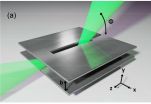(Press-News.org) PROVIDENCE, R.I. [Brown University] -- Terahertz radiation could one day provide the backbone for wireless systems that can deliver data up to one hundred times faster than today's cellular or Wi-Fi networks. But there remain many technical challenges to be solved before terahertz wireless is ready for prime time.
Researchers from Brown University have taken a major step toward addressing one of those challenges. They've developed what they believe to be the first system for multiplexing terahertz waves. Multiplexers are devices that enable separate streams of data to travel through a single medium. It's the technology that makes it possible for a single cable to carry multiple TV channels or for a fiber optic line to carry thousands of phone calls at the same time.
"Any terahertz communications application is going to need some form of multiplexing and demultiplexing," said Daniel Mittleman, professor of engineering at Brown and senior author of a paper describing the new device. "This is, to our knowledge, the first time anyone has demonstrated a viable strategy for multiplexing in the terahertz range."
The research was published September 14 in Nature Photonics.
Today's cellular and Wi-Fi networks rely on microwaves to carry voice conversations and data. But the increasing demands for data transfer are quickly becoming more than microwaves can handle. Terahertz waves have a much higher frequency and therefore more potential bandwidth. Scientists and engineers have only recently begun exploring the potential of terahertz waves, however. As a result, many of the components for a terahertz wireless network -- including multiplexers -- have not yet been developed.
The multiplexer that Mittleman and his colleagues have been working on makes use of what's known as a leaky wave antenna. In this case, the antenna is made from two metal plates placed in parallel to form a waveguide. One of the plates has a small slit in it. As terahertz waves travel down the waveguide, some of the radiation leaks out of the slit. It turns out that terahertz waves leak out a different angles depending on their frequency.
"That means if you put in 10 different frequencies between the plates -- each of them potentially carrying a unique data stream -- they'll come out at 10 different angles," Mittleman said. "Now you've separated them and that's demultiplexing."
On the other end, a receiver could be tuned to accept radiation at a particular angle, thus receiving data from only one stream.
"We think it's definitely a reasonable solution to meet the needs of a terahertz communication network," said Nicholas Karl, a graduate student at Brown and the paper's lead author. Karl led the experiments on the device with fellow graduate student Robert McKinney. Other authors on the study are Rajind Mendis, a research professor at Brown, and Yasuaki Monnai from Keio University in Tokyo.
One of the advantages to the approach, the researchers say, is that by adjusting the distance between the plates, it's possible to adjust the spectrum bandwidth that can be allocated to each channel. That could be especially useful when such a device is deployed for use in a data network.
"For example, if one user suddenly needs a ton of bandwidth, you can take it from others on the network who don't need as much just by changing the plate spacing at the right location," Mittleman said.
The group plans to continue its work to refine the device. A research group from Osaka University is collaborating with Mittleman's group to implement the device in a prototype terahertz network they're building.
"This is a first-generation, proof-of-concept device," Karl said. "There are still things we can do to improve it and we'll continue to study it."
Mittleman hopes that the work will challenge other researchers to start developing components for terahertz networks.
"The biggest impact this may have is it may just be the kick that people need to start thinking about this issue," Mittleman said. "That means they'll start coming up with clever ideas that are entirely different from this one."
INFORMATION:
The work was supported by the National Science Foundation and the W.M. Keck Foundation.
Note to Editors:
Editors: Brown University has a fiber link television studio available for domestic and international live and taped interviews, and maintains an ISDN line for radio interviews. For more information, call (401) 863-2476.
(SACRAMENTO, Calif.) -- Vitamin D insufficiency among the elderly is highly correlated with accelerated cognitive decline and impaired performance, particularly in domains such as memory loss that are associated with Alzheimer's disease and dementia, researchers with the UC Davis Alzheimer's Disease Center and Rutgers University have found. The effect is "substantial," with individuals with low vitamin D declining at a rate three times faster than those with adequate vitamin D levels.
The researchers said their findings amplify the importance of identifying vitamin D ...
Vitamin D insufficiency was associated with faster decline in cognitive functions among a group of ethnically diverse older adults, according to an article published online by JAMA Neurology.
In addition to promoting calcium absorption and bone health, vitamin D may influence all organ systems. Both the vitamin D receptor and the enzyme that converts 25-hydroxyvitamin D (25-OHD) to the active form of the vitamin are expressed in all human organs, including the brain. Thus, research has increasingly examined the association between vitamin D status and a variety of health ...
To encourage hospitals to improve quality of care, Medicare penalizes those with higher than expected rates of readmission within 30 days of discharge. The logic behind the penalties is that if patients receive high quality care, including proper discharge planning, they should be less likely to end up back in the hospital.
This seems straightforward, but it turns out that the social and clinical characteristics of a hospital's patient population that are not included in Medicare's calculation explain nearly half of the difference in readmission rates between the best- ...
Black children were less likely to receive any pain medication for moderate pain and less likely to receive opioids for severe pain than white children in a study of racial disparities in the pain management of children with appendicitis in emergency departments, according to an article published online by JAMA Pediatrics.
Racial and ethnic differences in the emergency department (ED) management of pain have been described, with lower rates of opioid prescription for black and Hispanic patients than for white patients. However, there are fewer studies in children. Appendicitis ...
The largest population genome sequencing effort to date is published today in Nature. A series of papers describing resources and application of the data is published at the same time in Nature, Nature Genetics, Bioinformatics and Nature Communications.
Rare genetic variants are changes in DNA that are carried only by relatively few people in a population. The UK10K study was designed to explore the contribution of these rare genetic variants to human disease and its risk factors.
"The project has made important new contributions towards describing the role of rare ...
This news release is available in Spanish.
Final OS and subgroup analysis of the pivotal study SAR-3007
First interim results of the Y-IMAGE prospective study showing real-world data for trabectedin in advanced soft tissue sarcoma (STS)
Clinical data of trabectedin in translocated-related sarcomas, and in advanced leiomyosarcomas and liposarcomas
Early clinical studies of PM1183 in combination with paclitaxel or cisplatin show a synergistic activity
Madrid, September 14, 2015: PharmaMar announces that it will show new data from clinical pivotal ...
This news release is available in French. We have known for some years that Alzheimer's disease is characterised by two types of lesions, amyloid plaques and degenerated tau protein. Cholesterol plays an important role in the physiopathology of this disease. Two French research teams (Inserm/CEA/University of Lille/University of Paris-Sud ) have just shown, in a rodent model, that overexpressing an enzyme that can eliminate excess cholesterol from the brain may have a beneficial action on the tau component of the disease, and completely correct it. This is the first ...
WASHINGTON, Sept. 14, 2015 -- It's a condition that turns the lives of millions of Americans upside-down: addiction. Whether it's alcohol, drugs, food or gambling, it can ruin lives. In support of National Recovery Month, which calls attention to substance abuse issues and treatment services, Reactions takes a look at the chemistry behind addiction. Check it out here: https://youtu.be/C6I3CHhBGeQ.
Subscribe to the series at http://bit.ly/ACSReactions, and follow us on Twitter @ACSreactions to be the first to see our latest videos.
INFORMATION:The American Chemical ...
DURHAM, N.C. -- Protected areas not only keep significant swaths of Indonesia's shrinking mangrove habitats intact, but also prevent emissions of carbon dioxide that would have been released had these mangroves been cleared, according to a study in the journal Ecological Economics.
Published online, the analysis examined the success of protected areas between 2000 and 2010, finding that their use has avoided the loss of 14,000 hectares of mangrove habitat.
"This is not a small number," said Daniela Miteva, a postdoctoral researcher at The Nature Conservancy and a Duke ...
Whether you have taken a side or a backseat in the discussion, the "food versus fuel" debate affects us all. Some say growing more biofuel crops today will decrease greenhouse gas emissions, but will make it harder to produce food tomorrow, which has prevented the U.S. from maximizing the potential of environmentally beneficial biofuels.
In a recent article, published by the National Academy of Engineering, University of Illinois' Gutgsell Endowed Chair of Plant Biology and Crop Sciences Steve Long and University of California's Philomathia Professor of Alternative Energy ...



